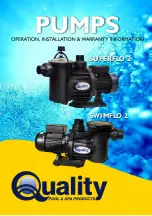
Instruction Handbook PFP-14hpKHL-EM-MR
- 21 -
C.E.T. Fire Pumps Mfg. This handbook is subject to change without notice,
Contact your local C.E.T. dealer or C.E.T. direct to ensure you have the latest version.
Problem
Probable cause
Remedy
The engine works but
the priming system
doesn't seems to be
able to fill the pump.
(part 2/2)
The pump is too far from the
water source
The volume of air to vacuum is
above the priming system
capacity
Always put your pump as close to the water source as possible. Having a very long suction hose will take more time
to prime and eventually overheat the mechanical seal. Never run the primer continuously for more than 2 minutes.
A part of the suction hose is
higher than the pump level
Air will get stuck in the higher
level hose section.
If possible, try to avoid having higher sections suctions hose than the pump level. Otherwise, close the discharge
valve as soon as the pressure drops and prime the pump again. Repeat the procedure to eliminate all the air pockets
in the hose, it is possible the procedure must be applied many times.
The priming system is not
maintained engage for long
enough
Only partially vacuums the
suction hose
Make sure to wait until some water comes out from the venturi before opening the discharge valve. The priming time
for a height of 10' (3 meters) shouldn’t take more than 45 seconds.
Faulty priming system
An accumulation of carbon
deposits or dust is obstructing
the priming system.
Carefully dismantle the priming system, clean it up or replace the components if necessary.
The engine runs fine,
but the pump output is
low.
The restrictions or energy
losses added to the system
reduces significantly the
pump performance.
The difference of elevation
between the end of the
discharge hose and the pump
is too high.
Reduce the elevation difference, use a smaller nozzle at the end of the hose to build more pressure (while reducing
the flow) or contact your local C.E.T. dealer for a more powerful model.
Old or malfunctioning intake
hose
It is possible on old suction hoses the inner liner rough up enough to cause friction loss and reduce capacity. In some
rare cases, the inner liner completely detaches from the outer wall making priming almost impossible.
Restriction on the suction
side
Obstructed intake or strainer
Check the strainer if it clogged with leaves, algae, rocks, etc. Clean it up and make sure the end of the suction pipe
doesn't touch the bottom of the water source. We recommend the use of a floating strainer.
The pressure gauges
indications are wrong.
Faulty or damaged pressure
gauges or their tubing
connections.
Check the connections of the pressure gauge and make sure they are watertight. Also check if there is no ice or
debris blocking the tube. Check and test the pressure gauges, change them if necessary.
The pump maximum flow has
been reached.
Over the maximum flow limit
the pump will begin to cavitate
Do not exceed the pump flow limit, cavitation will accelerate wear and damage the inner parts of the pump.
Содержание PFP-14hpKHL-EM-MR
Страница 12: ......



































